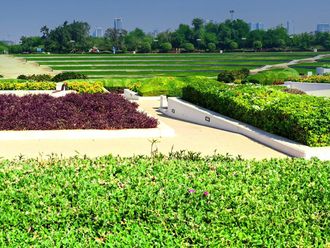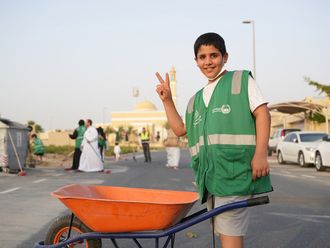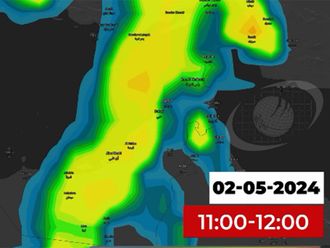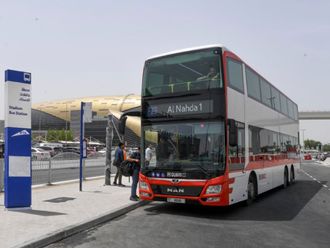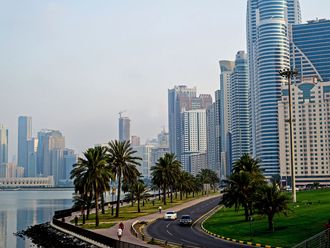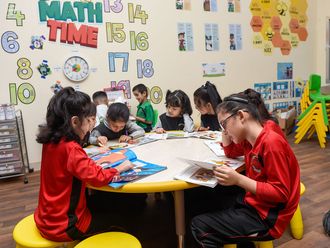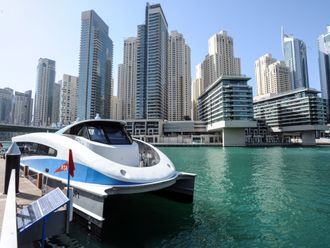The Al Shabab Club was established in 1974 with the merger of two Dubai clubs namely, Dubai Club and Al Arabi Club.
The two clubs agreed to merge as they were going through tough times. Al Arabi and Dubai were relegated to the second division in the league in the 1973-1974 season. Dubai Club were relegated following a decision taken by the Football Association after they withdrew from their match against Al Ahli. The FA decided to suspend them and relegated them to the second division. Al Arabi were automatically lost out as they finished at the bottom of the league table.
Abdullah Saqr, one of the members who established Dubai Club in 1970, said that some of the young football players in Fareej Al Marrar in Deira decided to establish their own club. Mohammed Abdullah Al Marri was the man behind the idea of establishing the Dubai Club along with Mattar Al Marri, Rashid Al Mazrouie, Abdullah Saqr, Mattar Ali Al Dhabbah, Darwish Al Marri, Obaid Hasan, Mohammed Khamis Al Marri, Saeed Ali, Dhahi Salmin, Ghanim Al Marri, Saeed Salboukh, Khalid bin Faris and Khalifa Ghanim.
The Dubai Club was housed in Fareej Al Marrar near Kuwaiti Hospital. The team trained and played matches in a small playground in Al Ghussais near the Al Ahli Club. The team's colours were red and white shirt with red shorts.
The first Dubai Club's board of directors was chaired by Ahmed Saif Balhasa, Butti bin Bishr, chairman of the Club's supreme committee, with members Khadim Suroor Al Massam, Mattar Al Marri, Rashid Saeed Al Marri, Humaid bin Zieban, Mohammed Abdullah Al Marri, Dr. Ahmed Saif, Mohammed Al Maydour, Mohammed Khamis Al Marri, Ahmed bin Darai, Darwish Issa Al Marri, Mattar Salim Sayah, and Abdullah Saqr for the culture committee.
Mahfouz Ibrahim and Mohammed Al Manzalawi, both from Egypt were the coaches who trained Dubai Club. They played in the Dubai league against Al Nasr, Al Ahli, Zamalik (now Al Wasl). They also played against clubs from Sharjah like Al Orouba, Al Khaleej, Al Omani. Abdullah Saqr said that the Dubai Club once defeated Zamalik 5-0, and after that match Al Ahli also crushed Zamalik 10-0.
On the other side of the spectrum, the Al Arabi Club was established in Hor Al Anz, Deira at the same time as the Dubai Club. The most famous players for Al Arabi at that time before the 'merger' were Yaqoot Juma, goalkeeper Salim Al Wali, brothers Ahmed and Hasan Fardan, Abdulah Mussa, Ali Hasan and Salim Juma. The colours for Al Arabi Club was green jersies and white shorts. They also played in the Dubai league before being relegated to the second division.
The relegation of the two teams to the second division in 1973-74 season, and the subsequent tough times they encountered necessitated the merger in order to become a more forceful unit and to win promotion to the first division.
During the merger the two teams agreed that they would play under the banner of Al Shabab Al Arabai. That was in 1974. The new team colours were going to be the former Al Arabi colours: green shirts and white shorts. The club continued to operate from their premises in Frij Al Murrar near the Kuwaiti Hospital.
Location map of Al Shabab Club. ©Gulf News |
The first full time coach to work with Al Shabab was Egyptian Rifaat Rajab Reeo who stayed from 1974 to 1978. Reeo helped Al Shabab gain promotion to the first division in 1974-75 after which they were never relegated again. The team at that time consisted of goalkeeper Saeed Salboukh, with Yaqoot Juma, Ahmed Al Marri, Ahmed Fardan, Abdullah Saqr, Mohammed Al Marri, Saeed Ali, Ghanem Al Marri, Khalid bin Faris, Dhahi Salmin and Salim Saeed.
Following the directives of the late UAE Vice President and Ruler of Dubai His Highness Sheikh Rashid bin Saeed Al Maktoum to build a soccer stadium for each of the four first division Dubai clubs. Al Shabab shifted in 1978 to their new stadium and premises in Al Mamzar.
Al Shahab now have their own soccer stadium with a seating capacity of 15,000. It is called the 'Maktoum bin Rashid stadium' in honour of the continuous support His Highness Sheikh Maktoum bin Rashid Al Maktoum, Vice President, Prime Minister and Ruler of Dubai, towards the club and to youth and sports in the UAE.
Al Shabab also have an administrative office. Later in 1984, they got their own indoor sports hall for basketball, volleyball, handball, table tennis and other indoor sporting activities.
The Al Shabab Club players play sport ranging from football, handball, volleyball, basketball, table tennis, and athletics. They also nurture budding sportsmen from the age groups of under-10, U-13, U-15, U-17 and U-19, till they graduate to the senior squads. The teams are trained by professional coaches from Europe, Brazil, and neighbouring Arab countries.
The Al Shabab squads in handball, volleyball, table tennis and athletics have won several championships and titles in the senior and youth level.
The Al Shabab senior football team was the only UAE club to win an overseas championship following their triumph in the GCC Clubs Championship in January 1992 in Muscat, Oman. The football squad have also won the UAE league title twice (1989-90, and 1994-95). Al Shabab have also lifted the President's Cup four times (1981, 1988, 1994 and 1997).
Al Shabab has seen the presence of various international coaches from Europe, South America, Africa and the UAE. The first two coaches were part-timers, Mahfooz Ibrahim and Mohammed Al Manzalawi. Then came the first professional coach Rifaat Rajab Reeo.
The Al Shabab list also includes coaches like Brazilian Danillo Alves, Murad Mahjoob of Tunisia, Claude Lorwa, France, Tony Piecnic, Poland, Illi Palaci, Romania, Abdullah Saqr, UAE and David Marinus from Holland. They are currently being trained by Brazilian Amarildo Tavares, a member of the 1962 World Cup squad.
Al Shabab Club is a constant provider to the UAE squads in all sporting disciplines. In football many players from Shabab represented UAE national teams and also at the Olympic, youth under-19 and under-17 levels.
Mohammed Al Marri, Yaqoot Juma, Saeed Salboukh, Salim Saeed, Hasan Ali, Mattar Al Awai, Issa Sanqoor, Khalid Abdullah, Yousuf Ozair, Ibrahim Ali, Abdul Qader Hasan, Issa Obaid, Juma Rashid, Ibrahim Ali, Walid Obaid, Yousuf Fikri, Abdul Khaleq Fadhil, Bakhit Saad, Khamis Saad are p


